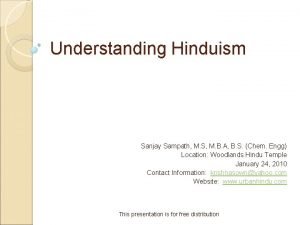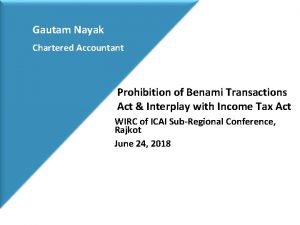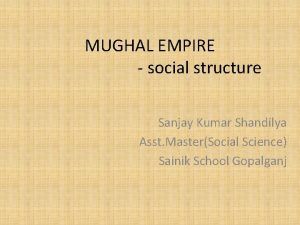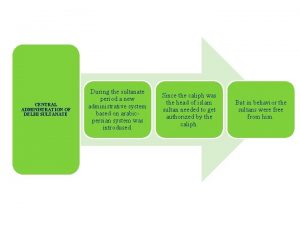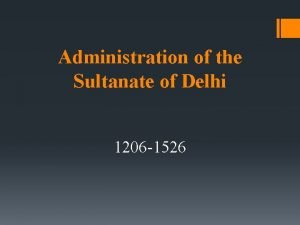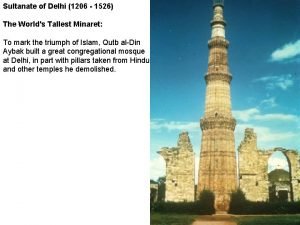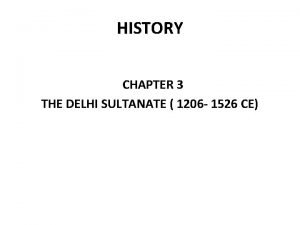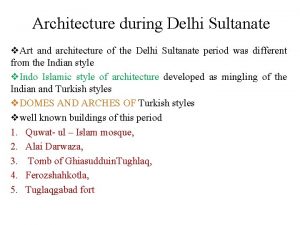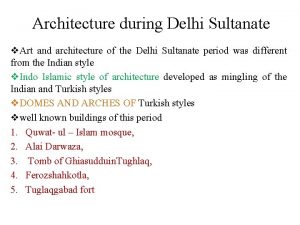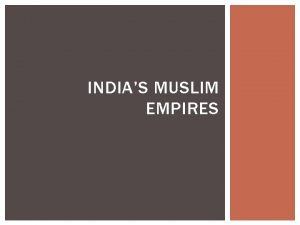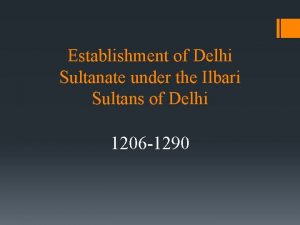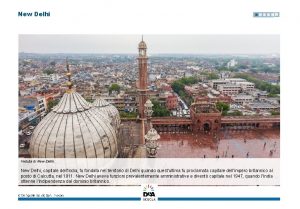THE DELHI SULTANATE Sanjay Kumar Shandilya Asst Master






































- Slides: 38

THE DELHI SULTANATE Sanjay Kumar Shandilya Asst. Master Sainik School Gopalganj


TarikhTawarikh ® Tarikh-History(singular) ® Tawarikh-Histories(Plural) ® Keep the following details in mind ® 1)The authors of Tawarikh lived in the cities ® 2)They often wrote histories in the hope of rich rewards.

Dehli-i-Kuhna ® After the Turkish conquest the city underwent a complete transformation. The small fort amidst the present ruins on the rocky ground became the nucleus of Delhi, referred to in the fourteenth century as Dehli-i Kuhna or “Old Dehli”. The Ghorian-Turkish conquerors started building their city around the fortress they had captured.

Siri ® Siri was a plain waste ground (sahra) almost adjoining the old city of Delhi to its north-east. The Imperial camp – Siri – is the creation of the reign of Alauddin Khalji (1296 – 1316). Initially, the settlement of Siri was called Lashkar or Lashkargah (army encampment), while the Qutb Delhi was known as Shahr (city).

Jahanpanah ® Jahanpanah was the fourth medieval city of Delhi established in 1326– 1327 by Muhammad bin Tughlaq (1321– 51), of the Delhi Sultanate. To address the constant threat of the Mongols, Tughlaq built the fortified city of Jahanpanah (meaning in Persian: “Refuge of the World”) all the establishments lying between Qila Rai Pithora and Siri Fort.



INTRODUCTION ® The Delhi sultanate is a noble example for the glory of medieval India. Its culture, art and architecture that exists even today is praiseworthy. The Sultans of Delhi ruled for quite a long period of 320 years during which there were achievements in different fields.


The period between 1206 AD and 1526 AD in Indian History is known as the Delhi Sultanate. ® During this period of over three hundred years five dynasties, (32 kings) ruled in Delhi. These were : ® The Slave Dynasty(1206 - 1290) ® ® The Khilji Dynasty (1290 - 1320) ® The Tughlak Dynasty (1320 - 1414) ® The Sayyad Dynasty (1414 - 1450) ® The Lodhi Dynasty (1451 - 1526)

THE SLAVE DYNASTY : 1206 AD o Qutbuddin Aibak (1206 -10 AD) o Aram Shah Qutbuddin(1210 -1211 AD) o Iltutmish (1211 -1236 AD). o Rukhuddin Firoz Shah (1236 AD). o Razziya Sultan (1236 -1240 AD) o Muizuddin Bahram ((1240 -1242 AD) o (Ghiyasuddin Balban. (1266 -1286 AD) o Muizuddin Kaiquabad(1287 -1290 AD)


Qutbuddin Aibak (120610 AD) ® When Ghori invaded India, Aibak came with his master and provided him his active support during wars. The successes of his master by and large depended on his military “skill. Ghori was immensely pleased with him and he appointed him his governor of the Indian empire. Aibak added power and prestige to the infant Muslim empire by his incessant labour and intelligence.

Time-Line ® ® ® ® 1192 -- Second Battle of Tarain Muhammad Ghuri defeats the Rajput king Prithviraj Chauhan, reversing a defeat that took place a year earlier (in the First Battle of Tarain, where else? ) 1192 -93 -- Aibak occupies Delhi Qutb ud-Din Aibak occupies and governs Delhi, acting on Muhammad Ghuri's orders 1194 -- Ghuri moves eastward Muhammad Ghuri defeats the raja of Kannauj and takes Banaras; his military successes are formidable 1204 -- Ghurids conquer NW Bengal Muhammad Bakhtiyar, a Ghurid general, establishes a base in northwestern Bengal 1206 -- Ghuri is assassinated The death of Muhammad Ghuri, who is assassinated back in Afghanistan (or in Punjab, according to other accounts), marks the breakup of the Ghurid kingdom 1192 -1290 -- the ILBARI or "Slave" dynasty Qutb ud-Din Aibak of the Ilbari Turks has seized Delhi, acting as a general for Muhammad Ghuri (and technically a military "slave" of his). He inaugurates the Ilbari dynasty that lays the foundations for the Delhi Sultanate. r. 1192 -1210 -- Qutb ud-Din Aibak He begins to build the Qutb Minar and the Quvvat ul-Islam mosque. Aibak formally rules as Sultan only after Muhammad Ghuri is assassinated (1206) back in Afghanistan.

® Qutubuddin was a generous king. He was also known as ‘Lakhbaksh’ (giver of lakhs) because hegave liberal donationsto the poor. He also started the construction of Qutub. Minar which waslater completed by Iltutmish. It was named in honour of Qutubuddin. Bakhtiar Kaki, a saint from Transoxiana who came to livein India and was greatly venerated by Iltutmish

Iltutmish (1211 -1236 AD). ® Iltutmish, also called Shams al. Dīn Iltutmish, Iltutmish also spelled Altamsh (died April 29, 1236) third and greatest Delhi sultan of the so-called Slave dynasty. Iltutmish was sold into slavery but married the daughter of his master, Quṭb al-Dīn Aibak, whom he succeeded in 1211.

Time-line


® ® ® ® Iltutmish was the second big ruler of the Mamlukdynasty. He was bestowed uponwiththe title of ‘Sultan’ by the Caliph of Baghdad. He suppressed rebellions tostrengthen the. Delhi. Sultanate. He initiatedthe‘Iqta system’ in which lands were granted to nobles andhis officersinstead ofsalary. Theywere then called Iqtadars. The Iqta holders were also given theright to collect revenue from their land. He introduced a new currency (silver tankaweighing 175 gms)which became the basis of the modern rupee. He tried to strengthen the northwesternfrontierto protect his empirefrommongolattacks He completed the constructionof the. Qutub. Minarand also built a mosque

Razziya Sultan (12361240 AD) ® Razia Sultan was the Sultan of Delhi in India from 1236 to 1240. She was the fifth Mamluk Sultan and also the onlywoman ruler during both the Sultanate and the Mughal Period. She was a great administrator. Razia tried to dress as a man in public, be it in court or on the battle field. She rode horses andled her army.

® She did not want herself to be addressed as‘sultana’ because it meant a wife of a Sultan. Hence she preferred being called as Sultan. Sh e established complete lawand order under her rule. The Turkish nobles did not accept her as their ruler andconspired against her. She was defeated and compelled toflee. She was finally killed in 1240. After Razia’s death a number of weak rulers took over the throne before, Ghiyasuddin. Balban, a. Turkishnoble, finallysucceeded her.

(Ghiyasuddin Balban. (1266 -1286 AD) ® Balban seizedpowerafter thedeath of N asir-ud-din(theyoungest son of Iltumuish). Herealized the intrigues of the Turkish nobles were the main cause of theweakness of the royal authority anddisorder prevailingin the kingdom.

THE KHALJI DYNASTY ® Jalaluddin Khalji established Khalji dynasty. The founder of Turkish dynasty, Jalaluddin Khalji was seventy when he ascended the throne. He defeated the decendants of Balban, being victorious came to power. He was kind hearted, mild and trusting in nature. The most important event during the reign of Jalaluddin was attack on the Yadava city of Devagiri.

Alauddin Khilji ® The New Emperor of Delhi, Alauddin Khalji, murdered his uncle Jalaluddin Firoze to gain the throne. It was his ambition to establish a vast empire. He introduced more controversial policies. All religious lands were confiscated and marriages between noble families were sanctioned by the King. The Emperor also introduced market and price control for foodgrains, cloth and other essentials. The land revenue was raised and made more efficient. Thus the Emperor enforced a highly centralised system of government



THE TUGLAQ DYNASTY ® Ghazi Malik ascended the throne as Sultan Ghiyasuddin Tughluq Shah and founded the third dynasty of the Sultanate. The Tughluqs belonged to the "Qarauna Turk" tribe.


® Among the Tughluq dynasty, Muhammad Tughluq and Firuz Tughluq stand out. Muhammad Tughluq has been grossly misunderstood and is assessed on account of his five ambitious projects.

® (a) transfer of capital from Delhi to Devagiri (1327), ® (b) introduction of token currency, ® (c) expedition for the conquest of Khurasan and Iraq, ® (d) conquest of Qarachil scheme, ® (e) increase in land revenue in the Doab



SAYYID DYNASTY ® Khizr Khan, the founder of the Saiyid dynasty had collaborated with Timur and as a reward he was given the governorship of Lahore, Multan and Dipalpur. In 1414, he invaded Delhi and became it’s master. Alauddin Alam Shah was the last ruler of the Saiyid dynasty and hardly did more than sustain the Sultanate in Delhi until 1451.



LODHI DYNASTY ® After thirty-seven years of chaotic rule, Bahlol Lodhi recognized as primus interpares by his compatriots, acquired control of Delhi and laid the foundation of the Lodhi dynasty. The Lodhis ruled for seventy-five years, were Afghans by race. The last Lodhi Sultan, Ibrahim Lodhi (151726) was defeated and killed by Babur in the first battle of Panipat in 1526. With the fall of the Lodhis, the Sultanate of Delhi also ended

 Ulugh khan
Ulugh khan Indian spices chart
Indian spices chart Khilji dynasty rulers
Khilji dynasty rulers Slave dynasty
Slave dynasty Delhi sultanate ap world history
Delhi sultanate ap world history Anand shandilya
Anand shandilya Sanjay sampath
Sanjay sampath Sanjay ghemawat
Sanjay ghemawat Sanjay ahuja amazon
Sanjay ahuja amazon Fay chang google
Fay chang google Dr sanjay dubey indore
Dr sanjay dubey indore Sanjay bajpai dst
Sanjay bajpai dst Sanjay dixit md
Sanjay dixit md Sanjay raman mit
Sanjay raman mit Google file system
Google file system Sanjay ghemawat
Sanjay ghemawat Ghemawat google
Ghemawat google Dr sanjay de bakshi
Dr sanjay de bakshi Sanjay ghemawat
Sanjay ghemawat Sanjay ghemawat
Sanjay ghemawat Sanjay vishin
Sanjay vishin Sanjay upreti
Sanjay upreti Jeff dean sanjay ghemawat
Jeff dean sanjay ghemawat Gupte nursing home
Gupte nursing home Sanjay dhole
Sanjay dhole What is a revuttal
What is a revuttal Sanjay tanwani
Sanjay tanwani Slidetodoc
Slidetodoc Spike prime gyro straight
Spike prime gyro straight Dr sanjay ahuja
Dr sanjay ahuja Sanjay gautam nayak
Sanjay gautam nayak Cbs audit
Cbs audit Sanjay ahuja md
Sanjay ahuja md Nus bza curriculum
Nus bza curriculum Sanjay gihar ias
Sanjay gihar ias Dr sanjay ahuja
Dr sanjay ahuja Sanjay verma
Sanjay verma Naveen garg iit delhi
Naveen garg iit delhi Diet ghumanhera
Diet ghumanhera






